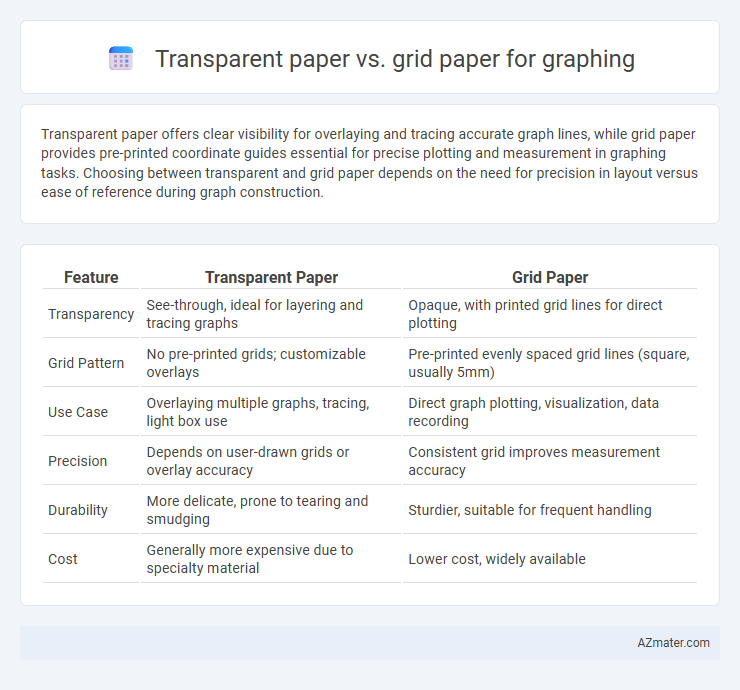Transparent paper offers clear visibility for overlaying and tracing accurate graph lines, while grid paper provides pre-printed coordinate guides essential for precise plotting and measurement in graphing tasks. Choosing between transparent and grid paper depends on the need for precision in layout versus ease of reference during graph construction.
Table of Comparison
| Feature | Transparent Paper | Grid Paper |
|---|---|---|
| Transparency | See-through, ideal for layering and tracing graphs | Opaque, with printed grid lines for direct plotting |
| Grid Pattern | No pre-printed grids; customizable overlays | Pre-printed evenly spaced grid lines (square, usually 5mm) |
| Use Case | Overlaying multiple graphs, tracing, light box use | Direct graph plotting, visualization, data recording |
| Precision | Depends on user-drawn grids or overlay accuracy | Consistent grid improves measurement accuracy |
| Durability | More delicate, prone to tearing and smudging | Sturdier, suitable for frequent handling |
| Cost | Generally more expensive due to specialty material | Lower cost, widely available |
Introduction to Graphing Paper Types
Transparent paper offers a clear surface ideal for overlaying patterns and making precise adjustments in graphing, while grid paper provides a structured layout of evenly spaced horizontal and vertical lines that facilitate accurate plotting of data points. Grid paper is commonly used in mathematics, engineering, and design due to its ability to guide measurements and maintain alignment, whereas transparent paper supports tracing and layering in complex graphing tasks. Both types enhance visualization and accuracy, but selection depends on specific graphing needs and project requirements.
What is Transparent Paper?
Transparent paper, also known as tracing paper, is a semi-transparent, thin material used to overlay drawings or graphs for precise replication and refinement. Its smooth surface allows clear visibility of the underlying grid or design, making it ideal for detailed graphing tasks where adjustments and comparisons are necessary. Unlike grid paper, transparent paper provides flexibility in layering multiple sketches without obscuring the original content.
What is Grid Paper?
Grid paper consists of a series of evenly spaced horizontal and vertical lines forming a grid of squares, commonly used for precise graphing and plotting mathematical functions. Its consistent spacing helps maintain accuracy in drawing graphs, charts, and geometric shapes by providing clear reference points. Unlike transparent paper, grid paper directly supports measurement and alignment, making it ideal for tasks that require detailed spatial organization.
Key Features of Transparent Paper
Transparent paper offers a smooth, translucent surface ideal for overlaying designs, making it perfect for tracing and refining graphing projects without obscuring underlying details. Its transparency allows users to accurately align and compare multiple layers of data, enhancing precision in graphing tasks. Unlike grid paper, transparent paper provides flexibility for custom grid creation and complex visualizations without predefined lines.
Key Features of Grid Paper
Grid paper features evenly spaced horizontal and vertical lines that create precise squares, ideal for accurate graphing and plotting data points. Its consistent layout simplifies scaling and measuring, enhancing clarity in mathematical and engineering drawings. The uniform grid structure supports detailed annotations and alignment of complex charts.
Accuracy and Precision in Graphing
Transparent paper enhances accuracy in graphing by allowing users to overlay and trace exact points and curves from reference sources, minimizing errors in data transfer. Grid paper promotes precision through its consistent and evenly spaced lines, which facilitate accurate plotting and measurement of data points along both axes. Combining transparent overlays with grid paper often yields the highest accuracy and precision in detailed graphing tasks.
Ease of Use and Visual Clarity
Transparent paper offers superior ease of use for graphing by allowing users to overlay and trace complex diagrams accurately without obscuring underlying data. Grid paper provides clear visual guidance with pre-printed evenly spaced lines, which aids in maintaining precision during manual plotting but can sometimes clutter the view with dense markings. When prioritizing visual clarity, transparent paper minimizes distractions and enhances focus on data points, while grid paper ensures consistent scale perception and alignment.
Applications in Education and Industry
Transparent paper enhances graphing accuracy in education by enabling overlaying multiple data sets for visual comparison, benefiting subjects like mathematics and engineering. Grid paper provides a structured framework for manual plotting and is widely used in classrooms for teaching graph basics and in industries for quick sketching of technical designs. Both mediums support precision but transparent paper's ability to layer graphs makes it invaluable for complex data analysis and presentations in scientific research and product development.
Cost and Availability Comparison
Transparent paper offers moderate cost and is widely available in art and office supply stores, making it suitable for precise layering and overlaying in graphing tasks. Grid paper is generally more affordable and easily found in bulk at educational and stationery outlets, providing a cost-effective option for routine graphing and note-taking. While transparent paper incurs a higher price due to its specialized nature, grid paper's widespread availability ensures consistent access for students and professionals.
Choosing the Right Paper for Your Graphing Needs
Transparent paper allows you to overlay multiple graphs for comparison, making it ideal for complex data visualization and layering analysis. Grid paper provides a consistent, pre-printed set of lines that help maintain accuracy and alignment when plotting points, essential for precision in mathematical or engineering graphs. Selecting between transparent and grid paper depends on whether your priority is visual layering flexibility or structured, clear point placement in graphing tasks.

Infographic: Transparent paper vs Grid paper for Graphing
 azmater.com
azmater.com